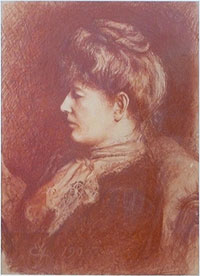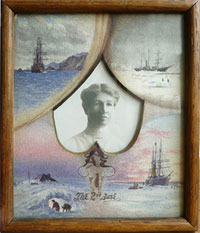The Forgotten Tasmanian
Article commissioned by The Mercury, published The Mercury Hobart, Tasmania : Mawson's Footsteps supplement 21 November 2011 pp 7
Charles Turnbull Harrisson was the only Tasmanian member of the Australasian Antarctic Expedition, led by Dr Douglas Mawson. Their departure from Hobart on 2 December 1911 will be re-enacted in December this year.
Harrisson grew up at Kingston, south of Hobart. His father was an orchardist on Brown's River Road, not far from the present site of the Australian Antarctic Division.
When Charles was born in 1867 the Harrissons had been in Tasmania for several generations. They were an enquiring family, fascinated by their unique environment. They explored, collected and recorded the life around them, corresponding with many well known scientists of their day. With this family tradition it is not surprising that Charles and his brothers were keen field naturalists, nor, with the Derwent Estuary and D'Entrecasteaux Channel in their backyard, that they were capable yachtsmen. Apparently without formal training, Charles Harrisson became a knowledgeable and respected biologist. Besides boats and wildlife, Charles' other passion was painting and drawing.
The orchard was sold after their parents died and the brothers separated. For a few years Charles followed his dream to be a painter, setting up a studio in Melbourne and working in the landscape genre, but as with so many artists, poverty was the result. Accepting that art alone would not support him he returned to Tasmania, satisfying both his interests by taking up a position as Collector for the University of Tasmania while also doing illustrative and artistic work for magazines, The Mercury and the Tasmanian Mail.

Charles Turnbull Harrisson Carrie.
Collection Geoff Harrisson
In 1900 Harrisson married Annie Caroline Butler, always known as Carrie. Like the Harrissons, the Butlers had long been in Tasmania, her great-grandfather, lawyer Gamaliel Butler, having settled there in 1824. Carrie, too, was an artist; painting was probably what brought them together. Their surviving oeuvre suggests that the young couple spent much time on painting expeditions into the Tasmanian bush and perhaps journeyed together to the challenging West Coast. They lived at Sandy Bay, a suburb of Hobart, and had two children, a boy born in July 1908 and a girl who was not yet two when her father went off to Antarctica with the AAE.
The AAE established three bases. Five men were left on Macquarie Island, another 17 under the leadership of Mawson at Commonwealth Bay, and eight were set down on a glacier, the Shackleton Ice Shelf, 2500 km west of the Main Base in February 1912. Their leader was the legendary Frank Wild. Despite the glacier creaking and groaning and threatening to break away at any moment, and in fact huge blocks did fall off into the sea, they survived for a year, charting and exploring a vast area. The heroic Captain Davis brought them back to Hobart in March 1913. Extraordinarily, nothing has been heard of them since.
The Western Base story is told in Harrisson's diary. But Harrisson's diary is more than just another Antarctic tale of cold and courage; it is a 240 000-word love letter to Carrie who was in his thoughts every day, almost every moment while he was in Antarctica.
He tells her everything, writing to her not only from the (relative) comfort of the hut, giving her the details of their daily life, work they were doing, what songs they sang, but even out on the glacier his love letter continued in pencilled shorthand. He describes sledging across the frozen land and how they fell into crevasses. He explains how they pitched their tent and huddled around the stove at the end of the day, cooking their rations while the blizzard thrashed their frail canvas shelter. He makes word images of the dogs fighting for hierarchy and tells her how he hated to kill the little birds, snow white petrels, to feed the hounds, but had to – the dogs were indispensable. As well, in pencil and in crayon he drew her pictorial images.

Charles Turnbull Harrisson Montage created in Antarctica.
Collection Geoff Harrisson
After Harrisson's cruel death at sea in 1914 we can imagine Carrie reading, rereading and reading again this diary, remembering his love and their life together. It must have felt like betrayal to give it up, yet she knew the only way to preserve the diary and the art works was to give them into professional care. Her generosity to the Mitchell Library, Sydney has preserved more than a record of Antarctic exploration, but also the expression of a great love.
Not all the artworks went to the Mitchell. Many beautiful and evocative pictures are held by the Harrisson family and some are in the collection at TMAG. Several of Carrie's works hang in the home of another Gamaliel Butler descendant, the Honourable Edward Butler, south of Hobart.
Mawson's Forgotten Men The 1911-1913 Antarctic Diary of Charles Turnbull Harrisson Edited by Heather Rossiter, will be launched in Hobart by Sir Guy Green on 13 November 2011. Illustrated with Harrisson's artwork and many formerly unpublished photographs, this account makes the Western Base unforgettable.